Women’s World Cup Expected to Heighten Interest in Women’s Sports, Lift Sales of Sports Gear
- Oops!Something went wrong.Please try again later.
- Oops!Something went wrong.Please try again later.
- Oops!Something went wrong.Please try again later.
- Oops!Something went wrong.Please try again later.
- Oops!Something went wrong.Please try again later.
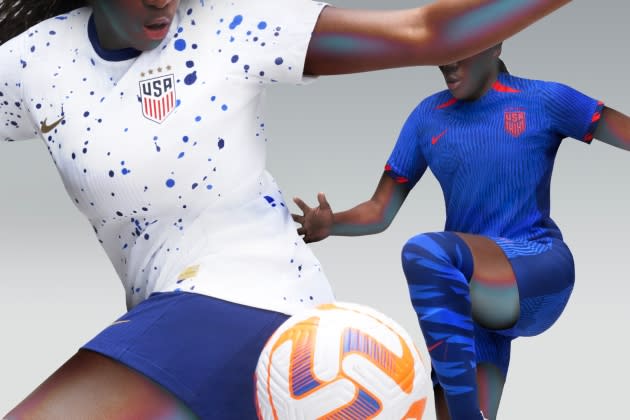
The FIFA Women’s World Cup kicks off in Australia and New Zealand Thursday and will run for a month. Teams from 32 nations will be vying for the title with the reigning back-to-back champion U.S. team among the favorites to win this year’s tournament. It is expected to draw more than 2 billion viewers, or nearly a quarter of the world’s population, according to Statista. First Lady Jill Biden helped to rev up interest in the sport by hosting a youth soccer clinic with Major League Soccer on the White House’s South Lawn on Monday. The event was meant to signify how sports can be a unifier and empower youngsters.
So it’s no surprise that the big sports brands have embraced the event.
More from WWD
Related Articles

10 Players to Watch During the 2023 FIFA Women’s World Cup

EXCLUSIVE: Prada Becomes Official Partner of the Chinese Women’s National Football Team
The sport benefits from the WWC’s abundance of global media coverage, the U.S. team’s potential to three-peat and the fact that many countries, especially in Western Europe, have realized that investing in women’s sports, in particular soccer, is a good bet for them, according to Mary Jo Kane, University of Minnesota professor emerita of sport sociology and director emerita of the Tucker Center for Research on Girls and Women in Sport. In addition, how engaged fans are in the tournament will depend on how competitive the matches are, she said.
“The media doesn’t cover this out of the goodness of their hearts. They cover it because it’s a good business deal for them. There’s a growing audience that they have finally recognized and respected. It’s a win-win for everyone in that sense,” Kane said.
Unlike in the aftermath of the Olympics — when the Games spiked interest in select sports like gymnastics, due partially to coverage and fans’ accessibility to competitions — women’s soccer, the world’s most popular sport, will continue to ride high when the tournament is over, Kane believes, since female players will continue to compete in leagues all over the world.
More than 24.47 million Americans play soccer at some level, according to the FIFA Big Count on World Football. In a survey of 207 countries, the grand total is now 265 million. But in a May 2023 survey, 25 percent of female respondents said they were interested in soccer, while 18 percent of male respondents said they were avid fans.
There is incredible momentum in women’s sports right now and we want to use the power of this moment to inspire people and champion female athletes.
Melanie Auguste, vice president, brand defining purpose and athletes for Nike
Tom Nikic, senior vice president at Wedbush Securities, was not so convinced, suggesting that the WWC is “moderately impactful” on major athletic brands. “A lot of times these big sports events end up being more of a marketing vehicle for the brands. It’s an opportunity to bring more attention to sports, to athletic wear categories and to the brands,” he said.
Putting that into perspective, Nikic cited how Adidas quantified that the direct revenue FIFA men’s world cup two years ago was 400 million euros and the company’s total revenue was 22.5 billion euros last year. “That tells you that sales of men’s World Cup products were less than 2 percent of Adidas’ revenue last year,” he said.
Allowing that WWC watchers may or may not buy WWC jerseys, they might be inclined to make their next footwear purchase with Adidas or Nike, Nikic said. More than anything, the halo effect of these global sports events can pay off for brands. After scoring a 1999 game-winning goal, Brandi Chastain’s decision to rip off her soccer jersey and reveal a Swoosh-logoed sports bra, “probably drove a lot of revenue for Nike beyond sales tied directly to women’s soccer,” he said. So much so, that many speculated at that time that Chastain’s gesture was a marketing-driven one.
While the participation of women and men in sports is nearly equal, the breakout of athletic brands’ sales don’t match that, he noted. Looking at Nike’s sales last year, Nikic said if you exclude the children’s business, as well as the Jordan brand, Nike’s men’s sales made up 71 percent and its women’s 29 percent. “That shows that clearly there’s an opportunity for Nike to narrow that gap and drive a bigger women’s business.”
While major athletic brands like Nike and Adidas are rolling out WWC-centered soccer jerseys and other pitch-ready styles, soccer apparel as a whole does not have the vast crossover appeal that hoodies, joggers and other styles do. And although standout players like Switzerland’s Alisha Lehmann, France’s Kadidiatou Diani and Wendie Renard, Brazil’s Marta Vieira da Silva, America’s Megan Rapinoe and Alex Morgan have helped to attract more people to women’s soccer, it still lacks the global zeal and financial marketing heft that the men’s side has.
Dick’s Sporting Goods is among the companies trying to change that by selling official USWNT jerseys and other merchandise. Dick’s Sporting Goods also will host 10 pep rallies countrywide during the WWC. Attendees will take in a DJ, face painter, soccer kick game, cheer cards and photo ops, as well as soccer clinics at three of those locations.
As part of a paid social media campaign, influencers like former WNBA Player Sue Bird showed off some of the Dick’s Sporting Goods looks in an Instagram video. The tie-in isn’t a disconnect, as the only sport that rivals soccer in the U.S. is basketball, both the WNBA and the NCAA’s “March Madness,” Kane noted.
Having seen “sustained momentum” in women’s soccer since the 2019 WWC, Jack Boyle, Fanatics Commerce’s global co-president of the direct-to-consumer business, said business in women’s soccer-related merchandise is up 80 percent leading up to this World Cup versus 2019. With fans being ”really engaged,” Fanatics expanded its assortment to offer more than 475 U.S. women’s national team products — up from 175 in 2019 — on its site. Boyle pointed to the “creative” updates from the brands, notably Nike, which has “added some fashion to the tech product.”
Although Fanatics does carry pieces from other teams, the primary focus is on the U.S. squad. Boyle said the top seller is jerseys, which represent just over half of the business. He described Morgan as the “most recognizable player,” and the soon-to-retire Rapinoe as a “huge fan favorite.” Boyle also singled out Sophia Smith, who has been touted as the next great American player, for her popularity as and suggested her jersey sales “could see a big spike” if she performs as expected during the event.
Fanatics has the ability to churn out jerseys nearly immediately if one player emerges as a standout, so that could impact sales over the run of the tournament as well. In addition to jerseys, Fanatics is seeing interest in T-shirts, scarves and headwear.
The heightened interest in the Women’s World Cup is part of a larger trend in women’s sports, Boyle said. He said in the last couple of years, the company has seen a “big surge” in sales of WNBA merchandise as well as other sports such as Major League Baseball, which have been creating more fashion-skewed merchandise to appeal to women.
“We’re expanding our assortment within all sports with more fashion and more player choices. Better product and assortment are bringing more women into the space,” he said.
Women’s sports are in the spotlight like never before as major brands and events strive to attract more women and girls — and their disposable income — as participants and spectators. Case in point: the U.S. Open women’s golf tournament was held at the famed Pebble Beach course in California for the first time earlier this month and covered live on network television.
The Ironman triathlon is splitting its world championships into two parts with the women getting their own opportunity to race in Kona, Hawaii, this October. In a recent interview with Triathlete magazine, the organization’s chief executive officer Andrew Messick predicted the WWC will have record-breaking attendance and cited the success of both the women’s rugby World Cup and the UEFA women’s European Championships as indicators of how “we’re in a real moment for women’s sports.”
The efforts of the major sportswear brands are helping to bring more women into the space.
Nike, which has been outspoken in its efforts to attract and embrace female athletes, is outfitting 13 federations for the WWC, including the U.S., the host countries of Australia and New Zealand, reigning Olympic champion Canada, European champ England and Asian Cup champion China. That means that 40 percent of all athletes will sport Nike kits created with advanced-performance materials developed with body-mapping technology and 4D data. The kits are also sustainable, with the jerseys and shorts made from recycled polyester from water bottles, and the federation crests, swooshes and trim are made from Nike Grind, its proprietary material made from scrap and recycled shoes.
All told, the brand has created the most comprehensive women’s soccer collection in its history with an assortment that ranges from high-tech performance pieces to lifestyle looks.
The kits include Leak Protection: Period technology in the brand’s Pro short as well as an updated bra offering. Fan versions of the kits are being sold to the public and include replicas of the home and away jerseys, the Pro shorts and other pieces.
On Monday, Nike launched “What The Football,” its largest soccer campaign to date composed of 11 individual athlete films featuring players from around the world including Morgan and Rapinoe of the U.S., Sam Kerr of Australia and Asisat Oshoala of Nigeria.
“There is incredible momentum in women’s sports right now and we want to use the power of this moment to inspire people and champion female athletes,” said Melanie Auguste, vice president, brand defining purpose and athletes for Nike. “As such, instead of a few athletes, Nike’s ‘What The Football’ campaign features 11 footballers from around the globe who are changing the game, highlighting how Nike is investing in women in a more meaningful way than ever before by listening, serving athletes holistically and collaborating to create positive change through sport.” She said the campaign “is an opportunity to use the full weight of our brand to support and champion female athletes. Not only do we hope to build a better game for them, but to expand sport for the next generation.”
Nike is hardly alone. Other sports brands also have high expectations for the Women’s World Cup.
“We see a heightened interest with record ticket sales, more fans and a bigger broadcast audience,” said Sina Neubrandt, global communications director for Adidas. “We think this will be the most impactful [tournament] ever.”
She said fans are passionate about the upcoming games, embracing both veteran and emerging players, and she expects the momentum from the games to remain after the last kick.
The German sports brand, which has been a partner in the FIFA Women’s World Cup since 1995, has created the official ball of the tournament, Oceaunz, and will dress the linespeople and referees, she said.
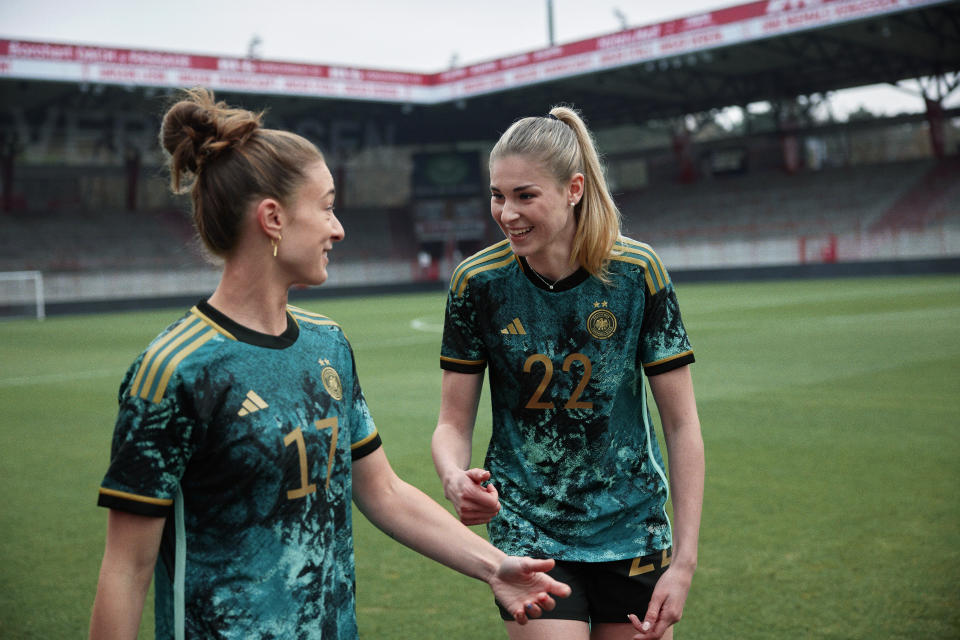
The company has created its largest-ever women’s kit for the 10 federations it is sponsoring with 15 percent more product. They include bespoke jerseys as well as bra fittings, special engineering and materials to ensure the correct fit and support. Athletes will also be offered Adidas’s FlowShield Technology, designed to prevent leaks that will be available in pitch shorts for the first time.
In addition to the product created for the athletes, Adidas has created a “wide offering” for fans.
But it’s more than just product; Adidas has an ongoing partnership with Common Goal where 1 percent of all World Cup ball sales will be donated to grow and support women’s sport as part of the group’s Global Goal 5 Accelerator program.
To promote the games, Adidas has launched a “star-studded campaign,” Neubrandt said, to “give the athletes a stage to shine and elevate emerging talent to attract a bigger audience and inspire girls.”
It brought soccer superstars David Beckham and Lionel Messi — whose signing with the U.S.-based Inter Miami is expected to give a major boost to the sport, especially Stateside — along with German footballer Leon Goretzka, English actor Ian Wright, and American actress Jenna Ortega together to star alongside current players Alessia Russo from the U.K., Germany’s Lena Oberdorf and Australia’s Mary Fowler. The films are part of a campaign titled “Play Until They Can’t Look Away,” set against the soundtrack of SL2’s song, “On a Ragga Tip.”
“There is no denying that while all World Cups are special, this summer’s tournament feels like one that is really bringing us to a tipping point for the women’s game,” Neubrandt said. “We’re on a journey but if brands take a stand to elevate women’s games, this can just be the beginning and there will be exciting times ahead.”
Under Armour is also making a big push for the games. Last week the Baltimore-based company introduced two technical products — the biomechanically-designed Women’s UA Magnetico Elite 3 FG Soccer Cleats at $250 and latest HeatGear Armour High Sports Bra at $45 with a compression fit and keyhole for improved ventilation.
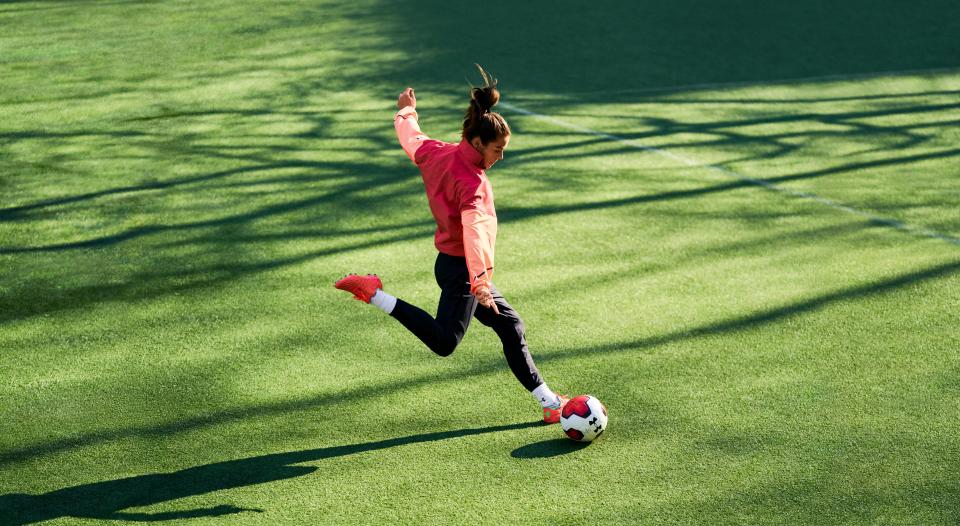
At the same time, the sports brand released a film featuring U.S. soccer star Kelley O’Hara and England’s Alex Greenwood alongside up-and-coming female hip-hop artists Gaylyn (USA) and Nadia Rose (England). The artists perform a musical track that pays homage to music’s impact on sport culture and showcases the skills that brought both athletes to the top of their sport. In addition, the brand featured global soccer stars Emily Fox, Jayde Riviere, Chloe Logarzo and Laura Freigang on its digital channels.
Paul Nugent, senior vice president of global marketing for Under Armour, said the music video concept was seen as a way to reach its target consumer, the 16- to 24-year-old, and the initial reaction has been “phenomenal” to this different approach.
Like other sports brands, Under Armour is also heightening its focus on women and as part of its She Who Plays initiative, the company is donating nearly $500,000 in equipment to sports organizations that serve young girls around the U.S.
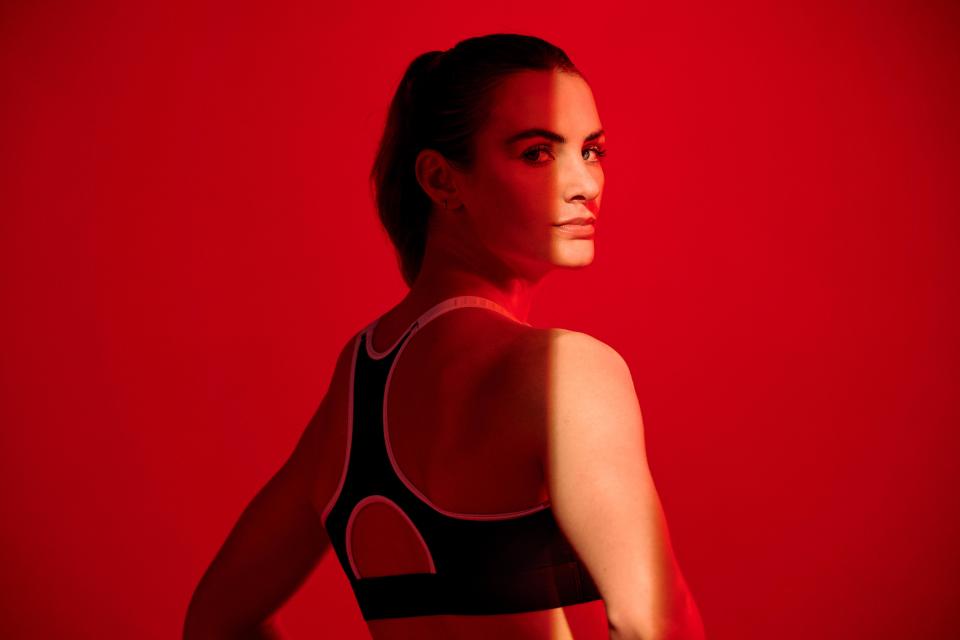
Nugent said this marks the company’s first female-focused soccer campaign and came as a result of the heightened interest the company has seen in women’s soccer. “We’ve been blown away with the rise in interest,” he said, and jumped at the “cultural opportunity to really lean in and celebrate the bad-ass women going to the World Cup.”
He said this women’s-centric focus and building product specifically for females is “a starting point for us. But we’re invested in making female athletes the best that they can be.”
He said the company “saw great traction” when it introduced a women’s-specific basketball shoe, so bringing that same effort to soccer, the most popular global sport, was a natural next step.
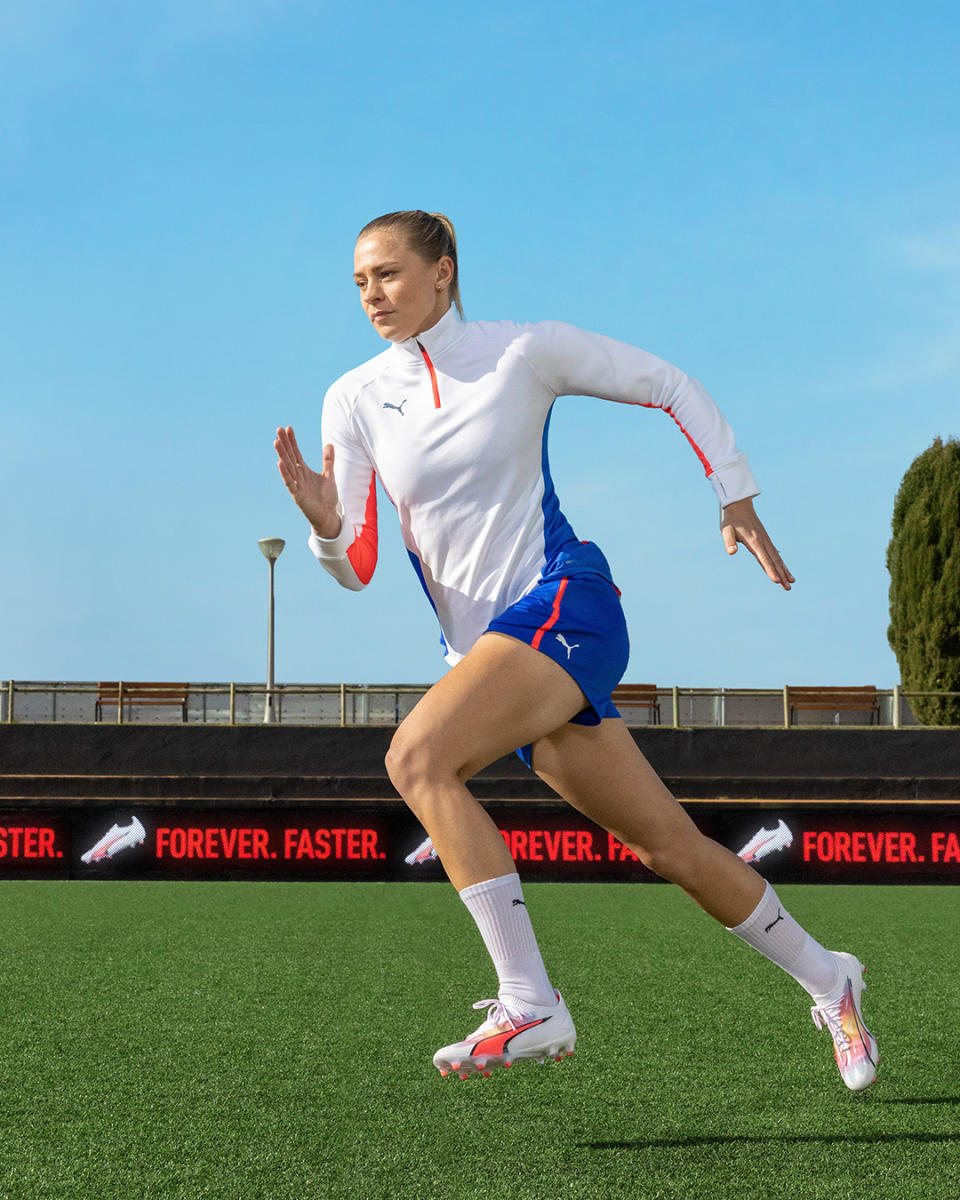
Puma also created a women’s-specific Ultra cleat for the Women’s World Cup featuring its Ultraweave upper, Pwrtape technology that is intended to provide support for faster changes of speed and direction, and a Speedplate outsole for traction and propulsion. The cleat will be worn by the brand’s athletes including Fridolina Rolfö, Alex Popp and Tamires. The brand also created two other women’s-specific cleats, the Future and the King, that were offered for sale alongside the Ultra earlier this month.
“We have continued to develop our unique women’s specific fit offering, which is now used by over 90 percent of our female athletes,” said Stephanie Viera, product line manager for teamsport footwear at Puma.
Best of WWD

